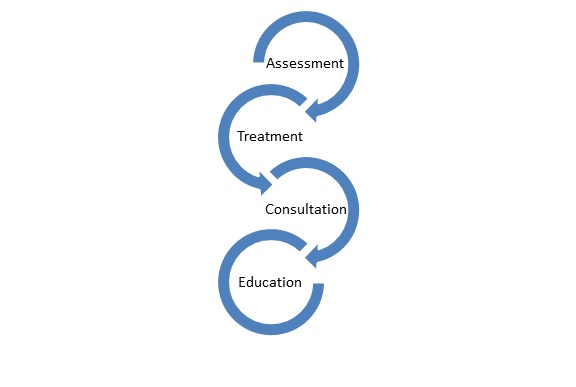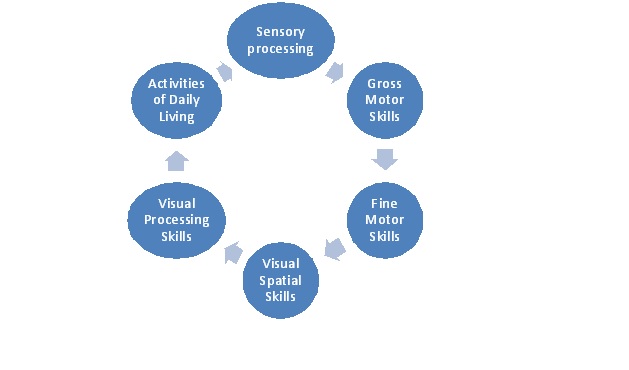Our services include comprehensive assessments or screening assessments, treatment and consultation services.
ASSESSMENTS
The purpose of the assessment is to identify any challenges that your child may be facing that would prevent him/her participating fully in any activity on a day to day basis. It is important to note that while the therapist may be assessing individual components, she will integrate this information to provide you an understanding of how these separate components combine to make certain tasks and demands on your child challenging, and sometimes impossible. Depending on the age and presentation of your child, a full occupational therapy assessment would include the therapist assessing the following areas:
Shown above are the components of the occupational therapy assessment. The occupational therapist will be able to integrate the information she gathers in order to help you understand why your child struggles to be successful in everyday activities such as dressing, feeding, hygiene tasks, playing, and/or academic tasks such as reading, writing, spelling and math.
Sensory Processing
While the ability to process sensory information is a complex one, a simple explanation of how this process works is provided. The first step in making sense of the world in which we live is to be able to take information from the world, and to process it and make sense of it in order to respond to it.
The senses that provide us with information from outside of our bodies are often referred to as the far senses. These include information received from sight (vision), hearing (auditory), touch (tactile), smell (olfactory) and taste (gustatory).
There are another set of sensory receptors that provide us with information, but this time they provide us with information about what is going on inside our bodies. These are often referred to as the near senses and include the vestibular (movement) system and the proprioceptive (deep pressure and heavy work) system.
In typical development, once we receive sensory information from our far and near senses, our brain processes and integrates this information and then is able to organize an appropriate response. This process takes place in a seemingly seamless manner.
For some children this process of sensory processing, which includes receiving, integrating and responding to information, does not work efficiently and effectively. The child may have difficulty in one or all of the areas. He/she may not perceive and receive information or process and integrate the information in a “typical’ manner, or be able to produce an appropriate response to the information that is perceived.
The net result is the child may have difficulty in connecting with the world in appropriate ways. Accordingly, the world can become a frightening place and this can result in behaviours which are unregulated and challenging to deal with.
Gross Motor Skills
Typically, we think of gross motor skills as being any movement that requires the use of the large muscles of the body. This would include movements such as running, jumping, hopping, skipping, galloping and catching and throwing a ball.
Underlying the ability to use the big muscles of the body is a number of other factors, which may affect how well these big muscles work. These include things such as muscle tone, muscle strength, range of motion of joints, consolidation of reflexes, postural control, ability to balance and motor planning.
A child who presents with poor gross motor skills may be clumsy, fall often, prefer to watch TV or play computer games, avoid outside play, and tire easily. In addition, the child may struggle to learn new movements and skills such as riding a bicycle. Complications such as excess weight may become an additional concern.
Fine Motor Skills
Fine motor skills are often associated with the role of the occupational therapist working with children. These include any movement which includes the use of the small muscles of the body. While we will usually associate fine motor skills with the use of the hands, it will also include the small muscles that are found in and around the mouth and which are used for eating and talking. The occupational therapist will also be concerned with the child’s ocular motor control which is provided by the small muscles surrounding the eye and controlling eye movements.
A fine motor assessment will look at how the child uses the small muscles of the hand when holding, grasping and manipulating objects. This will include how the child holds a crayon or pencil or how they manage to use a pair of scissors or how they use a knife, fork and spoon to eat. The therapist will be looking at how the child uses the two hands together. She will be observing how the underlying sensory and gross motor systems are providing a foundation on which to build strong fine motor skills.
If there are eating concerns, the therapist is likely to include a feeding assessment which will provide further information on what may be making the feeding process difficult for the child.
A child struggling with fine motor skills may avoid fine motor tasks altogether. Mothers often report that their child did not like to draw, paint, cut or may prefer finger foods.
Visual Spatial Skills
Visual spatial skills is an umbrella term for a number of components that begin to develop as your child begins to move and interact with the world around him/her. As this interaction develops the child begins to learn about his or her body. He/she begins to develop a body awareness. Body awareness, in itself, has numerous components but it is necessary for the child to develop the next stage, which is a laterality or an internal awareness that the body is comprised of two sides and these two sides interact with each other. From this emerges an external awareness that the body has an up and a down, and a front and a back and a left and a right. This is now referred to as directionality. As the child grows he /she then develops the ability to relate itself to an object in space. This is referred to as position in space. The final stage is when the child can relate itself to many objects in the space around him/her. Visual spatial skills continue to develop, becoming more complex, as the child learns to relate to, and understand the complex nature of relationships in his/her environment.
At the same time directionality develops, the child is exploring and experimenting and begins to realize that one hand is a little better at doing tasks than the other hand. Now emerges a preferred or dominant hand. The other key component that develops is the child’s ability to cross his midline and this is important as it helps to strengthen the communication between the two sides of the brain.
Children who do not develop good spatial skills often do not have a good sense of where they are in space. They can appear clumsy. They may not understand directional concepts such as up, down, front, back, left and right. They struggle with positional concepts such as on, under, next to, beside. They may struggle to follow directions when there is a directional or positional command. They may struggle to recognize patterns. They may not easily pick up the foundation math concepts.
Visual Perceptual Skills
Visual perceptual skills refer to the processes which help us to make sense of our visual world. As humans, we tend to process most information through our visual system and so it is important that we can do so quickly and efficiently. The first thing we want to ensure is that the ocular motor system is working efficiently. If the therapist is concerned that your child is struggling to move his/her eyes in a fluent manner, she may refer you to a behavioural or developmental optometrist for further investigation. She will also assess the components of visual perception which help your child to perceive and understand their visual world. These include visual discrimination, visual memory, visual form constancy, visual sequencing, visual closure, visual analysis and synthesis and visual motor integration.
A child presenting with difficulty in all or some of these areas typically may find the task of learning to read, write, spell and master simple math concepts very challenging.
It is further noted that all of these visual perceptual components have partners in the world of auditory perception, which is how the child perceives information through his hearing sense. If the occupational therapist is concerned that auditory perceptual challenges are present for your child, the therapist may refer you to a speech and language therapist or/and audiologist.
Strong visual perceptual skills form a strong foundation for reading, spelling, writing and understanding math concepts. Children with weak visual perception may present differently depending on the area in which they struggle. They may struggle to find information as they do not know what is important and what they should focus on. They may not see consistency in information and so when they look at information it is always changing. They may see the world in pieces and not know how to put those pieces into the whole. Thus their world tends to be very disconnected and difficult to make sense of.
Activities of Daily Living
The occupational therapist will want to know what concerns you have in your child’s ability to be independent in the daily tasks that they may encounter. These may include tasks such as dressing, eating, managing hygiene tasks such as toileting brushing teeth, tying shoelaces, playing independently and general success at school.
TREATMENT
Treatment can be tailored to meet the child’s needs and therapy requirements. Therapy sessions can be provided for on a weekly, bi-weekly or monthly basis. Therapy sessions may be individual or the child may be treated in small groups if this is deemed beneficial to facilitating the child’s development and goals. All therapy sessions are designed to be client and family centered and based on evidence based practice. Each therapy session provides an opportunity for the therapist to monitor progress and adapt the program as required. While therapy sessions currently take place at the child’s home, a clinic space is in the process of being established, so watch out for the soon-to-be launched “THERAPY HUB”
CONSULTATION
It is important that all people involved with your child understand why your child may be presenting with particular behaviours or may have difficulty in participating in the demands asked of them. Consultation to parents, family members, teachers, or other caregivers is available. Consultation my including explaining a report or discussing any recommendations or strategies that have been made.
EDUCATION
For many of the children we work with, there are no easy and quick solutions. The best intentions of parents, teachers and caregivers can be thwarted because they do not really understand the mechanisms that make the life of the child so challenging.
We believe that sharing and learning from each other is a key in the success our children will experience. With this in mind, we will provide formal and information sessions for parents, teachers and schools on requested topics.
List of Workshops:
We believe in the plasticity of the brain
and that all children
have the potential for change
when provided with the right input,
at the right level,
for the right amount of time.


